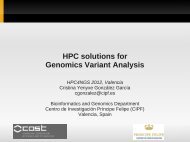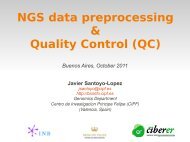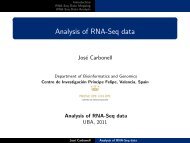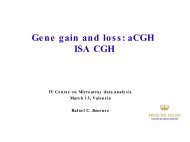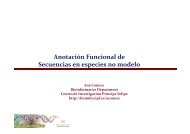Introduction to NGS technologies - Bioinformatics and Genomics ...
Introduction to NGS technologies - Bioinformatics and Genomics ...
Introduction to NGS technologies - Bioinformatics and Genomics ...
Create successful ePaper yourself
Turn your PDF publications into a flip-book with our unique Google optimized e-Paper software.
Solexa (Illumina)<br />
•Over 90% of all sequencing data is produced on Illumina systems.<br />
•Uses a “sequencing by synthesis” approach:<br />
• DNA is broken in<strong>to</strong> small fragments <strong>and</strong> ligated <strong>to</strong> an adap<strong>to</strong>r.<br />
• The fragments are attached <strong>to</strong> the surface of a flow cell <strong>and</strong><br />
amplified.<br />
• DNA is sequenced by adding polymerase <strong>and</strong> labeled reversible<br />
termina<strong>to</strong>r nucleotides (each base with a different color).<br />
• The incorporated base is determined by fluorescence.<br />
• The fluorescent label is removed from the termina<strong>to</strong>r <strong>and</strong> the 3’<br />
OH is unblocked, allowing a new base <strong>to</strong> be incorporated<br />
•Started with 35 bp, increased now <strong>to</strong> up <strong>to</strong> 150 bp<br />
•One run can give up <strong>to</strong> 10-600 Gb, 300-6000 million paired-end reads<br />
•75-85% of bases at or above Q30




